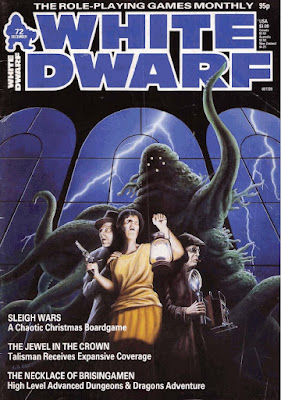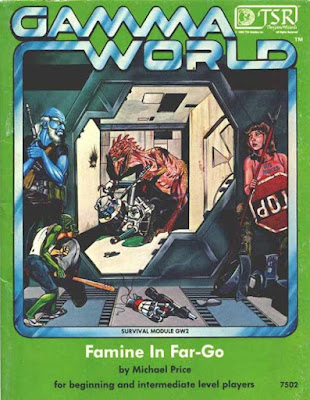"Open Box" kicks off with a review of FASA's Doctor Who Role Playing Game, which the reviewer likes a great deal (8 out of 10). Even more favorably reviewed is Chaosium's Pendragon (9 out of 10) and I find it difficult to argue with such an assessment. The final review is the Pacesetter boardgame, Wabbit Wampage (6 out of 10). I had completely forgotten about the existence of this game, but I now recall seeing many advertisements in Dragon for it (and the Chill-related game, Black Morn Manor) during the mid-1980s. I never played either them, though, from the review, it doesn't seem like I missed much.
I'm going to let Dave Langford's "Critical Mass" pass without comment, because, as is so often the case, none of the books he discusses are ones I've read or about which I have anything to say, good or bad. Far more interesting is Alastair Morrison's "The Jewel in the Crown," which is both an overview of Talisman and an expansion of it. Morrison provides several new spell and adventure cards for use with the game, in addition to a new character – the Samurai. All are given new color cards, complete with (I think) John Blanche illustrations that the reader can either cut out or photocopy from the issue. I've long been a big fan of these kinds of articles. I remember a similar one for Dungeon! that appeared in the first volume of The Best of Dragon of whose rules addition I made use.
"Fear of Flying" by Marcus L. Rowland – there he is again – is a short Call of Cthulhu scenario that takes place aboard a Tarrant Tabor triplane that can carry twelve passengers at a speed of over 100 miles per hour! Naturally, the presence of a carving of Nyarlathotep on board leads to all sorts of Mythos mayhem as the plane makes it way through the air. What makes the scenario memorable is not so much its Lovecraftian elements as its setting, the remarkable aircraft on which the characters are traveling. In my opinion, it's a good use of the 1920s setting, because it highlights the ways that the world of a century ago was both very much like and very much unlike our own. To my mind, that's the best use of any historical seting and one of which I wish we saw more in RPG adventures.
"Scientific Method" by Phil Masters is a brief but interesting look at super-scientists within a superhero setting. What makes the article useful is that Masters looks at both sides of the equation – super-scientist heroes (and sidekicks) as well as villains. Graeme Drysdale's "The Necklace of Brisingamen" is an AD&D scenario for characters of levels 7–10. As its title suggests, it's inspired by Norse mythology, specifically the necklace of the goddess Freya. The adventure concerns a long ago conflict between Freya, Loki, and their followers and how that conflict continues to color contemporary events in and around the village of Stonehelm. This is a lengthy and compelling scenario, one that provides the referee with a lot of material to use, as well as plenty of challenges for the player characters.
"Origin of the PCs" by Peter Tamlyn looks at the virtues and flaws of character generation systems. The article rambles about a number of related topics before coming to the "conclusion" that "character generation is a complex and wide-ranging activity and that different methods will appear best depending on who is using the system, how much time and effort they want and/or need to put into getting results, and what sort of character is to be created." What insight! Much more fun is "Sleigh Wars" by Chris Elliott and Richard Edwards, a 2–4 player boardgame of "merry Xmas mayhem" in which four "Santas" – Santa Claus himself, Anti-Claus, General Nicholas B. Claus III Jr., and The Ongoing Spirit of Christmas Where It's At At This Moment in Time – compete with another to deliver all their presents before the others. It's a completely ridiculous game, but it looks like fun.
"Recommended Reading" by Marc Gascoigne offers up a couple of new Mythos tomes for use with Call of Cthulhu. "All Part of Life's Rich Pageant," meanwhile, presents a random events table for use with AD&D. The events include such things as "arrested," "conversion attempt," "friendship," and "witness crime," among many others. Each is described, along with ideas on how to implement them in a game. While I could, of course, quibble with some of the entries or with their particular arrangement, it's difficult to find fault with what is essentially an adventure seed generator to aid the referee. As a proponent of the oracular power of dice, I'm largely in favor of tables like this, though one must still be wary of falling prey to randomness fetishism. It's a fine line to walk and each person will draw it in a different place, which is no knock against the general principle.
"Dioramas" is a new series about gaming miniatures by Joe Dever, the first part of which focuses on planning and preparation. Disappointingly, the color photographs that accompany the article aren't of miniature dioramas at all. I hope that future installments might remedy this, since I admire the hard work that goes into the creation of top-notch miniature scenes. The issue also includes more "Thrud the Barbarian," "Gobbledigook," and "The Travellers," the last of which continues its protagonists' playing out of the classic Traveller scenario, Shadows.
As I have written several times previously, this issue is from the period when I was no longer reading White Dwarf regularly but instead only picked up the occasional issue here and there, as I came across them in hobby or book shops. Consequently, my memories of the period are much hazier and I have a lot less affection for these issues. Indeed, it won't be much longer before I'll be in wholly foreign territory: issues I have never seen, let alone read. Once that happens, I'll re-evaluate whether to continue with this series or move on to a different gaming periodical with which I am more familiar, such as Polyhedron.





















